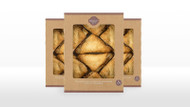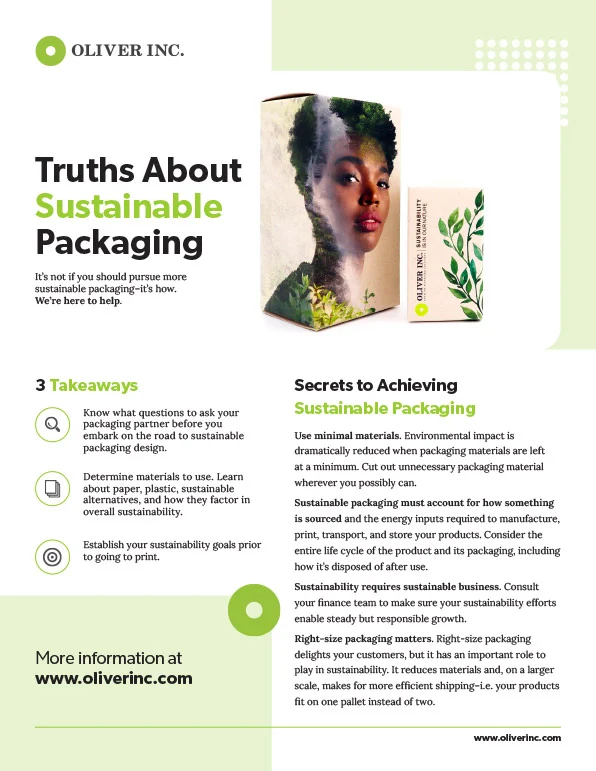Achieving Recyclable Food Packaging
Posted by Oliver Inc. on 7th Jul 2023
There are many things you can do to make your food packaging recyclable (and ensure consumers actually recycle it), but it can be challenging deciphering which packaging options are the most sustainable.
For instance, which is more recyclable and has a smaller carbon footprint, folding cartons or plastic containers? That depends.
An experienced food packaging supplier will help you determine which route is right for you, expanding your brand’s ability to connect with the growing number of environmentally conscious consumers.
Here’s how you can achieve that in the food and beverage industry.
Why You Should Consider It
More and more consumers are concerned with the ecological impact of their purchases.
In fact, 43% of American consumers view the environmental impact of product packaging as extremely or very important, while 60 to 70 percent are willing to pay more for sustainable packaging, according to a 2020 report from global consulting firm McKinsey.
Put simply, consumers want brands to reflect their deeply held values.
By embracing recyclable food packaging, you not only foster brand loyalty among eco-friendly buyers, but you generate further opportunities to create some PR buzz. It’s not uncommon for brands to be featured in news stories and shared across social media channels for moving away from single-use plastics toward greener alternatives.
Ultimately, it’s becoming increasingly difficult for brands to ignore their ecological impacts, and consumers expect food brands to lead with their sustainability initiatives.
Not doing so can leave a bad taste in their mouths.
What Qualifies as Recyclable Food Packaging?
Designed to be collected, separated, and processed, recyclable food packaging can be used again as raw material for other purposes. In other words, unlike plastic film and polystyrene, recyclable food packaging reduces the volume of materials that end up in landfills.
Instead, it becomes post-consumer recycled paper and other plastic products.
As you might expect, not all types of recyclable food packaging are created equal. Generally, plastic, paperboard, and cardboard are accepted by most recycling centers, while packaging made from materials such as styrofoam and plastic film are not.
It’s important for consumers to check with their local recycling centers to determine which types of food packaging materials can be recycled. If your consumers live in targeted geographic regions, you may want to verify which materials are typically taken by recycling centers in the area.
Some examples of recyclable food packaging are:
- Beverage cans are made from steel or aluminum and can be recycled nearly indefinitely without losing quality or strength.
- Plastic bottles consist of polyethylene terephthalate (PET) or high-density polyethylene (HDPE), and have the ability to be turned into new bottles, containers, or fibers.
- Cardboard tubes and boxes are derived from paper. These can be reformed into new paper products, such as paper towels, tissues, or writing paper.
- Plastic tubs, pots, and trays are frequently made from polypropylene (PP) or polystyrene (PS). They can be recycled into new plastic products, such as garden furniture, pipes, or insulation.
- Folding cartons are constructed from paperboard and can be reshaped into new paper products, such as egg cartons, tissue boxes, or paper bags.
- Foil trays are usually aluminum based and can be recycled nearly indefinitely into new aluminum products, such as cans, foil, and even car parts.
Examples of non-recyclable food packaging that should be avoided:
- Polystyrene packaging consists of expanded polystyrene (EPS) foam and cannot be recycled due to its low density and high contamination risk.
- Plastic film derives from low-density polyethylene (LDPE) or other thin plastics and cannot be recycled due to its low value. Plus, it’s incredibly difficult to sort and process.
- Multi-material packaging is made from a blend of plastic, paper, metal, or glass, and cannot be recycled due to the complexity and cost of separating the materials.
Effectiveness of Recycling Food Packaging
It’s worth noting that many materials can’t be recycled infinitely. And while recyclable food packaging can find new life after being discarded by consumers, it doesn’t always end up at the recycling center. All it takes is one apathetic consumer to abbreviate your recyclable food packaging’s life by throwing it in the trash.
In fact, the national recycling rate in the United States is currently a mere 32%, according to the Environmental Protection Agency (EPA), with a goal of reaching 50% by 2030.
Rates are even more disheartening when you look exclusively at plastics. Between 5-6% of plastics are recycled in the United States, per a 2022 report by Beyond Plastics, a nationwide project based at Bennington College dedicated to reducing plastic waste.
So, while you hope your food packaging will be reused or recycled by consumers, much of it eventually reaches a landfill. However, by integrating recycleability into your food packaging design, you increase the chances it will see multiple uses throughout its life, before reaching its final resting place.
Each time it’s recycled means one less piece of food packaging ends up in the landfill.
Paperboard vs. Plastic
Choosing between folding cartons and plastic containers is not easy, economically or environmentally. The most sustainable path isn’t always clear.
Folding cartons and plastic containers have different sources, processes, and impacts on the environment. So, should you use paperboard or plastic for your food packaging?
Plastic Containers
Plastic comes from petroleum, a non-renewable resource that takes hundreds of years to decompose. Recycling and using plastic wisely is essential to reduce its environmental harm.
Plastic containers are mainly made of polyethylene, a synthetic polymer that can be molded into various shapes and sizes. You may also employ polystyrene, polypropylene, polyethylene terephthalate, and polyvinyl chloride in your food packaging.
Durable, lightweight, and adaptable, it’s easy to see why plastic remains a major player in food packaging. Plus, it’s economical when produced in large quantities.
Folding Cartons
Derived from trees, a renewable resource that can be replanted and regrown, there’s a reason so many sustainable food brands turn to paperboard to protect their products.
However, trees take time to mature and can still be harvested unsustainably if forests are irresponsibly managed, damaging ecosystems. Folding cartons are made of paper, which is the product of pulping wood chips in water (and sometimes chemicals). Paper is then dried into thin sheets.
Once paper has been discarded by consumers, it decomposes and regenerates the soil (presuming it doesn’t contain harmful chemicals and isn’t rotting on top of trash in a landfill somewhere). It’s incredibly green.
Naturally, paper is more renewable than petroleum, but it also requires more energy to produce. (Don’t forget to include carbon emissions in your environmental calculations.)
Plastics take centuries to degrade, but paper has a larger carbon footprint (at least, during manufacturing). But determining their sustainability value becomes more convoluted throughout the life of a folding carton.
At the end of the day, most plastics aren’t recycled, compared to the roughly 68% of paper and paperboard products recycled annually in the United States, per a 2023 report by Statista. These plastics are then buried or incinerated, releasing toxic gasses into the atmosphere.
So, yes, plastics are more energy efficient to produce, but their carbon footprint may grow several times larger than paper when measuring its entire life cycle. Plastics are also dramatically lighter in weight compared to paper, meaning the energy needed to ship them is comparatively less.
There are other factors you may evaluate, but given paperboard’s lower carbon footprint and much higher recycling rate, folding cartons are usually the greener option for recyclable food packaging.
You may also consider sustainable paperboard alternatives, such as casein protein and hemp- and cotton-based substrates.
Ensuring Your Folding Cartons Are Recyclable
Folding cartons are one of the most common forms of food packaging used, and for good reason. They can accommodate a high degree of customization, extensive decorative effects, and are excellent for protecting your food products.
So what can you do to ensure your folding cartons are more recyclable?
Here are some elements to consider:
- Use foil sparingly as a design element. Foil logos on paper boxes are fine, but mylar foil paper inside boxes is not. Keep foil stamping coverage below 40% to avoid confusing recycling machines.
- Tell users how to recycle your cartons. Make it easy for your consumers to recycle your packaging. Use clear and simple instructions or symbols to show them what to do.
- Pick materials that support recycling. Choose sustainable packaging materials that have low environmental impact, such as paper, cardboard, or other renewable fibers. Try to reduce plastic use if possible, especially plastic films.
- Link your cartons’ recyclability to your sustainability story. This will generate brand loyalty among the growing number of environmentally friendly consumers. This grows your market share and increases the chances your food packaging will actually be recycled. You can employ visual cues, such as QR codes, to direct them to more information about your eco-friendly practices.
Partnering With a Sustainable Food Packaging Supplier
If you’re dedicated to achieving recyclable food packaging, then you should seek out a partner committed to sustainability in all they do. A domestic food packaging supplier will help you realize that.
With facilities in Ohio, Oklahoma, Massachusetts, Virginia, and New York, Oliver is a printing and packaging company built around sustainability. This enables us to remain in close proximity to our clients and their customers. Which means our supply chains are shorter and carbon footprints are smaller.
Working with a domestic food packaging supplier such as Oliver means you can easily monitor the packaging process. Plus, you experience the benefits of a one-stop solution.
Oliver simplifies the food packaging process. Rather than coordinate with multiple manufacturing partners, you have all you need under one roof. From design and printing to fulfillment, Oliver works closely with you, minimizing the potential for errors and disruptions that come with multi-collaborator projects.
When you partner with Oliver, you can be certain your folding cartons and other recyclable food packaging are sourced from responsibly managed forests. We guarantee that. Our paperboard products are certified by nonprofits such as Forest Stewardship Council (FSC), Sustainable Forestry Initiative (SFI), and Programme for the Endorsement of Forest Certification (PEFC).
After all, sustainability is in our nature.






